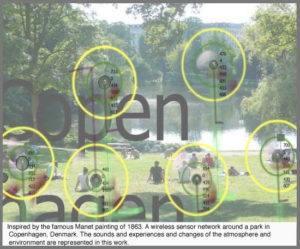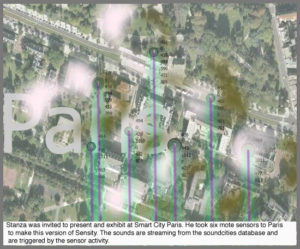



‘Instead of adopting narrative threads from other media, I am interested in the currency that exists already in the city space. These works are focused on the wider picture of city experiences which are being played out in real time.’ Stanza.
Unseen geographies of our cities lay around us with areas yet to be discovered. Much of it seldom noticed as we pass through them in our everyday lives. The traces of our journeys through each city leave temporary presences. There was once a time where many would have believed these traces were spirits, psychic remains, registrations and impregnations onto objects and environments, from what was possibly a traumatic event in time. Are contemporary technologies a realisation of this belief? These technologies that record our movements in time, are no longer odd, or alluding to being mystical occurrences but the switching of sensors and transmission of radio waves through the ether.
The sensors deployed for Sensity measure temperature, sounds and light as well as the humidity and vibrations, around each recording and transmission unit. Depending on the deployment (there have been several across different cities in Europe) the units are used for different combinations of these discrete elements. But rather than taking finite measurements at a moment in time, mathematically, the notation is delta, registering the change over a period of time. The difference between one state to another that brings our attention to the changes around us, where we may imagine the world around us has not altered very much, but the data gathered from the sensors tells a different story altogether. It draws our attention to the ever-shifting mood of the city. This ebb and flow, viewed over a period of time, might, one imagines, bring about some kind of anthropomorphism in our relationship to the environment. In the same way that an anonymous animal, viewed over a period of time, gradually shows personal characteristics, so does a city. It becomes a barometer of all our psychic imprints on it. As Stanza says in the project documentation:
‘These artworks represent the movement of people, pollution in the air, the vibrations and sounds of buildings. They are in effect emergent social sculptures visualizing the emotional state of the city.’
Stanza regards this change as vital to the work,
‘Some things change for the better but sometimes they don’t; one thing is for sure; things change’.
Presumably this means the physical space as well as the social aspect (psychic well-being?) of the environment. The two are like a bio-feedback loop. But what is it that Sensity reveals to us in its visualisation of the city?
One of the moods of the city is ‘fear’ of the consumer class. A very contemporary class, replacing what we once knew as the working class, caught within the trappings of an economical reliant state of bourgeois anxiety. The consumer classes who, it might be suggested, consume without question and are more likely, in their drunken Saturday night release from the pressure of state-endorsed nullification of the desire to think, to destroy and cause chaos. The CCTV cameras aren’t trained on the would-be anarchist, or political dissident. It’s the masses that scare the state, with their potential to destroy property. A hungry, voyeuristic CCTV culture is there all around us, and it works more subtly than we might imagine[1].
Sensity can be viewed as a way to challenge or exploit the power balance of state imposed surveillance systems like CCTV, mobile phone monitoring and car monitoring (for example, cameras installed on buses to monitor the illegal use of bus lanes in the city). There is, of course, an ongoing struggle between the population on one side and the privacy concerns of the population on the other side. And if these spaces are public, how much of our own surveillance technology are we allowed to deploy? The argument over public space becomes not just one of ownership, but of how much freedom we are allowed in those spaces. Anyone who has spent time within a shopping mall, soon comes to realise that you are only visiting those public spaces, and are allowed little more than the ‘privilege’ of being within them to consume products, that’s the deal.

It would be good to imagine that the changes monitored by Sensity are working in favour of the ordinary public, rather than the elite who are most often served by the surveillance technologies. After all, aren’t most CCTV cameras deployed into areas of commerce and entitlement? Nobody cares what the general public actually gets up to, as long as property isn’t destroyed and the reputation of the city isn’t compromised. Of course, when the government talks about the general public, they mean the British working class, the consumerist, a celebrity-obsessed class. And in particular, those of us employed to work in the inner-city space, rather than live there. You can visit, work and spend your money here, but you must return to your own dwellings! Owen Hatherley points out this ambivalent attitude in the introduction to his book, Militant Modernism (2009):
‘The pervasive class hatred only slightly below the surface of British life (what else does the word ‘chav’ signify?) centres on the feared or ridiculed estate dweller.’
But whereas Hartherley is discussing the issue of Modernist architecture in relation to political standpoints and the class system, Sensity, through its monitoring of the movement through those architectural spaces, presents a human-centred perspective tracing our movements, rather than the monumental buildings.

If we are truly to once again have ownership of our own spaces, then isn’t the right to deploy surveillance technology one of those rights? The argument of course, is as much about who owns the data, as who is collecting it. And to what use it will be put. Stanza takes the data to measure our existence in public spaces to ‘create artistic metaphors.’ These metaphors are the visualisations of existence projected into the exhibition space and online. These metaphors are like seances, drawing out the spirits of the city. Tapping into the spirit metaphor again, it is possible to communicate with the city and the inhabitants who are the cells and organs of the spaces. Sensity offers the city a chance to tell a different story.
On the Sensity website, clicking on the images activates the simulation of the recordings. The slightly blurred images of cities or park locations are covered with puffy clouds of ‘data’ moving out from the points that mark the locations of the sensors. The effect is hypnotic and gives more to the patient viewer than the casual observer. This isn’t the sort of artwork that the viewer should cast a casual glance at and then move on. It requires time to understand the change in the data. Where there is audio content, the click and stutter of noise begins to build a symphony of sounds that can hover just at the edge of recognition before fading away. Numbers form and then change, always offering a sense of movement.
What is being observed within the gallery is something that has already happened, an historical moment that has passed. Conversely, this gives the work its strength as a comment on contemporary time. The work sits within time and acts as a reminder that we are constantly in flux. Despite the many questions that it raises about the cityscape and urban life, this constant change offers a reminder that there is always the future to look forward to. If everything is constantly changing, there is always the possibility of reaching possible states of alternate contentment.
[1] For a more in-depth discussion on the surveillance society, read Marc Garrett’s article on the fourth radiator festival. Where he refers to the 2006 research document A Report on the Surveillance Society For the Information Commissioner produced “by a group of academics called the Surveillance Studies Network.”